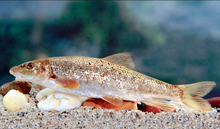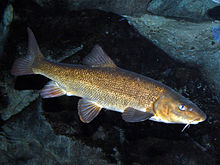Barbus
| Barbus | ||||||||||||
|---|---|---|---|---|---|---|---|---|---|---|---|---|

River barbel ( barbus barbus ) |
||||||||||||
| Systematics | ||||||||||||
|
||||||||||||
| Scientific name | ||||||||||||
| Barbus | ||||||||||||
| Daudin , 1805 |
Barbus is a genus of medium to large sized carp fish . Barbus species are found in the western Palearctic .
Over a period of several decades, it was also assigned numerous species from eastern and southeastern Asia and the Indian subcontinent, which today belong to other genera ( Dawkinsia , Desmopuntius , Haludaria , Pethia , Puntigrus , Puntius , Striuntius and Systomus ). In October 2014, the genus Arabibarbus was introduced for two species of Barbus from the Euphrates and Tigris basins and from Yemen and a newly described species from the Hadramaut . The species of sub-Saharan Africa originally assigned to the genus Barbus were placed in the genera Enteromius , Labeobarbus and Pseudobarbus in a revision of the carp fish subfamily Cyprininae published in February 2015 . Genetically, the genera differ mainly in the number of chromosome sets . Barbus and Pseudobarbus are tetraploid , Enteromius diploid, and Labeobarbus hexaploid .
distribution and habitat
The distribution area of the genus extends, with the exception of the cold regions of the north, over almost all of Europe , northwestern Africa , Asia Minor , the catchment areas of the Aral Sea and the Caspian Sea . The animals live ground-oriented in a variety of freshwater habitats from lakes to slow-flowing rivers to mountain streams.
features
The elongated body is almost round at the front and becomes somewhat flatter towards the rear end. In profile, the back appears convex, the belly side is almost straight. There is a pair of barbels at the tip of the snout, another pair at the corners of the mouth. The clearly developed lips of the lower mouth have numerous papillae, the upper lip is completely covered by them. In some species, the lower lip is enlarged and also completely papillary. It usually goes into a backward, flap-like appendage above which is separated from the jaw by a deep furrow. Some species lack this process or it is very small and then without a furrow. The lower lip of this species is soft in the middle and papillae only on the sides.
With only one exception, the dorsal fin starts in the middle of the body in all species , only in B. brachycephalus it sits further forward. The last unbranched soft jet can be thin and flexible but also thick and ossified. The dorsal fin of most species has eight split rays, but seven or nine are also possible. The anal fin is always supported by five split rays, the last undivided soft ray is thin and flexible.
The pharynx are arranged in three rows with their number in the first row varying depending on the species. Most European and some Caucasian and West Asian species have five teeth in the first row. Four of them are flattened, similar to an incisor, but have a hook-shaped tip followed by a small grinding surface. The fifth pharynx is cylindrical in shape, it ends either in a grinding surface or in a point, but then without barbs. Almost all species from the Iberian Peninsula , a number of West Asian and North African species are missing one of the four incisor-like fangs. B. longiceps with an intermediate form of the fifth tooth and the species B. graceus and B. albanicus occurring in Greece show unusual pharyngeal dentition . In the two Greek species, the fangs are asymmetrically distributed. Three teeth are flattened, the fourth is cylindrical but blunt with a grinding surface and only on the left side is a fifth, smaller and curved, tooth.
Fixed scales cover the entire body with the exception of the head. Their number along the straight and complete sideline varies greatly within the genus, ranging from 43 to 103 scales.
species
- Albanian barbel ( Barbus albanicus Steindachner, 1870 )
- Barbus anatolicus Turan et al., 2018
- Barbus balcanicus Kotlík, Tsigenopoulos, Ráb & Berrebi, 2002
- Barbus barbulus Heckel, 1847
- River barbel ( Barbus barbus (Linnaeus, 1758) )
- Barbus bergi Chichkoff, 1935
- Barbus biharicus Antal, László & Kotlík, 2015
- Barbus borysthenicus Dybowski, 1862
- Barbus caninus Bonaparte, 1839
- Barbus carottae (Bianco, 1998)
- Barbus carpathicus Kotlík, Tsigenopoulos, Ráb & Berrebi, 2002
- Barbus ciscaucasicus Kessler, 1877
- Barbus cyclolepis Heckel, 1837
- Barbus cyri De Filippi, 1865
- Barbus ercisianus Karaman, 1971
- Barbus euboicus Stephanidis, 1950
- Barbus goktschaicus Kessler, 1877
- Barbus grypus Heckel, 1843
- Barbus haasi Mertens, 1925
- Barbus karunensis Khaefi, Esmaeili, Geiger & Eagderi, 2017
- Barbus kubanicus Berg, 1912
- Barbus lacerta Heckel, 1843
- Barbus longiceps Valenciennes, 1842
- Barbus lorteti Sauvage, 1882
- Macedonian barbel ( Barbus macedonicus ) Karaman, 1928
- Trout mullet ( Barbus meridionalis Risso, 1827 )
- Barbus niluferensis Turan, Kottelat & Ekmekçi, 2009
- Barbus oligolepis Battalgil, 1941
- Barbus peloponnesius Valenciennes, 1842
- Barbus pergamonensis Karaman, 1971
- Barbus petenyi Heckel, 1852
- Tiber barbel ( Barbus plebejus Bonaparte, 1839 )
- Prespa barbel ( Barbus prespensis ) Karaman, 1924
- Western Balkan barbel ( Barbus rebeli ) Koller, 1926
- Barbus reinii (Günther, 1874) ; Morocco
- Barbus rionica Kamensky, 1899
- Crimean barb ( Barbus tauricus ) Kessler 1877
- Barbus thessalus Stephanidis, 1971
- Italian barbel ( Barbus tyberinus Bonaparte, 1839 )
- Barbus urmianus Eagderi et al., 2019
supporting documents
- ^ A b Petru M. Bănărescu, Nina G. Bogutskaya: The Freshwater Fishes of Europe , Aula-Verlag, Wiebelsheim 2003, ISBN 3-89104-659-6 . (Volume 5. Cyprinidae 2, Part II: Barbus). P. 1.
- ↑ Rohan Pethiyagoda, Madhava Meegaskumbura & Kalana Maduwage: A synopsis of the South Asian fishes referred to Puntius (Pisces: Cyprinidae). Ichthyological Exploration of Freshwaters, Volume 23, No. 1, Pages 69-95, June 2012, © by Verlag Dr. Friedrich Pfeil, Munich, Germany - ISSN 0936-9902
- ↑ Maurice Kottelat : The fishes of the inland waters of Southeast Asia: A catalog and core bibliography of the fishes known to occur in freshwaters, mangroves and estuaries. ( Memento of the original from January 6, 2015 in the Internet Archive ) Info: The archive link was automatically inserted and not yet checked. Please check the original and archive link according to the instructions and then remove this notice. (PDF; 6.6 MB) The Raffles Bulletin of Zoology, November 2013, Supplement No. 27, pages 482 and 483.
- ↑ Borkenhagen, K. (2014): A new genus and species of cyprinid fish (Actinopterygii, Cyprinidae) from the Arabian Peninsula, and its phylogenetic and zoogeographic affinities. Environmental Biology of Fishes, October 2014, Volume 97, Issue 10, pp 1179-1195.
- ↑ Lei Yanga, Tetsuya Sado, M. Vincent Hirt, Emmanuel Pasco-Viel, M. Arunachalam, Junbing Li, Xuzhen Wang, Jörg Freyhof, Kenji Saitoh, Andrew M. Simons, Masaki Miya, Shunping He, Richard L. Mayden (2015 ): Phylogeny and Polyploidy: Resolving the Classification of Cyprinine Fishes (Teleostei: Cypriniformes). Molecular Phylogenetics and Evolution, February 2015, doi: 10.1016 / j.ympev.2015.01.014
- ↑ Bănărescu, Bogutskaya: S.3,4
- ↑ Maurice Kottelat, Jörg Freyhof: Handbook of European freshwater fishes . Kottelat and Freyhof, Cornol (Switzerland) and Berlin 2007, ISBN 978-2-8399-0298-4 , p. 112.
- ↑ a b c d Bănărescu, Bogutskaya: p.2
- ↑ Eagderi, S., Nikmehr, N., Çiçek, E., Esmaeili, HR, Vatandoust, S. & Mousavi-Sabet, H. (2019): Barbus urmianus a new species from Urmia Lake basin, Iran (Teleostei: Cyprinidae ). International Journal of Aquatic Biology, 7 (4): 239-244.






